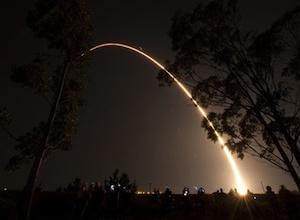
In the early morning hours of Friday, October 28, the NPP satellite blasted off from Vandenberg Air Force Base in California. To the profound relief of the engineers that have witnessed continual project setbacks due to technical failures and mismanagement, the rocket carried NASA’s next generation climate monitoring satellite, and launched us into the next age of Earth observation.
NPP is short for National Polar-orbiting Operational Environmental Satellite System Preparatory Project. Way shorter, in fact. But if its name is weighty, so is its instrumentation. As a “Preparatory Project” the satellite is a testbed for systems that will outfit more advanced satellites in the future. The number of sensors packed into its five instruments is enough to make NPP scoff at its starward-looking orbital friends. Some 30 different kinds of data are to be collected, such as atmospheric temperature, moisture, and pressure, ozone mapping, the tracking of dynamic surface processes such as wildfires, ice movements, and vegetation changes, even the amount of plankton in the sea. With these instruments the NPP will be able to monitor both daily weather patterns as well as long-term climate variation. It will be the first satellite to measure both simultaneously.
“NPP will help us understand what tomorrow brings, whether by ‘tomorrow’ we mean tomorrow’s forecast, or whether we mean years or decades down the road,” Andrew Carson, an NPP program executive, said in a space.com video.
Soaring 512 miles over the Earth’s poles, the $1.5 billion satellite paves the way for a joint polar-satellite system (JPSS) – a pair of polar-orbiting satellites to be launched in 2016 and 2019. Four of the five instruments on NPP have never flown before, although the kind of data they collect has been collected before on other satellites. The NPP mission, which will last five years, will test the four new instruments against the rigors of space and give the data collection network on the ground a test run. The amount of data beamed down will be massive – equivalent to 800 DVD’s worth of information per day.
The following NASA video is a nice – if a little hammy – summary of what NPP brings to climate and weather monitoring.
Even though this is a test run, the US’s weather alert agency, the National Oceanic and Atmospheric Administration (NOAA), will be using the data to improve their weather forecasting. A crucial part of being an effective early warning system is to identify potentially severe weather – particularly hurricanes – with enough lead time to for people to prepare. The current NOAA lead time for hurricanes is five days. With NPP’s high-powered instrumentation, the NOAA expects to stretch that lead time to seven days.
For climate researchers, the NPP means their long-term measurements will continue. NASA’s premier triumvirate of Earth observation satellites – Terra for land, Aqua for water, and Aura for air – will be ending their missions over the next two or three years.
The NPP is the realization of a effort conceived nearly twenty years ago. Originally called the National Polar-orbiting Operational Environmental Satellite System, plans were to have six identical satellites orbiting at the poles to provide complete sensory coverage of the planet. But technical setbacks and mismanagement (the Pentagon and NOAA/NASA continually butted heads) have dogged the project and have resulted in a cost increase from $6.5 billion to $13.9 billion. Launch dates were also delayed by five years, for both NPP and JPSS, which is scheduled to launch in 2014.
NASA has been collecting climate data for decades. What a shame it would have been if that vitally important thread of information had been severed. Ideally the two joint-polar system satellites would have begun their work when Terra, Aqua, and Aura ended theirs, but NPP is more than sufficiently equipped to fill the gap.



